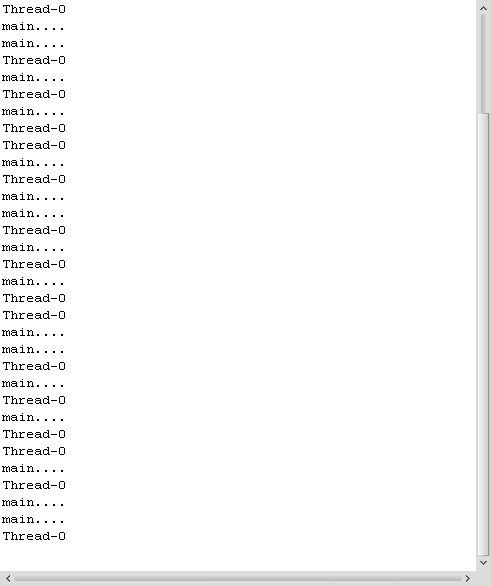1 package edu.thread.test; 2 3 public class ThreadTest2 implements Runnable { 4 @Override 5 public void run() { 6 getTicket(); 7 } 8 9 /** 10 * 得到车票 11 */ 12 private synchronized void getTicket() { 13 while (true) { 14 System.out.println(Thread.currentThread().getName());// 得到当前线程名称 15 try { 16 Thread.currentThread().sleep(1000);// 睡眠 17 } catch (InterruptedException e) { 18 // TODO Auto-generated catch block 19 e.printStackTrace(); 20 } 21 } 22 } 23 24 public static void main(String[] args) { 25 ThreadTest2 test = new ThreadTest2(); 26 // 新建线程启动购买车票 27 new Thread(test).start(); 28 new Thread(test).start(); 29 new Thread(test).start(); 30 new Thread(test).start(); 31 while (true) { 32 System.out.println("main...."); 33 try { 34 Thread.currentThread().sleep(1000);// 睡眠 35 } catch (InterruptedException e) { 36 // TODO Auto-generated catch block 37 e.printStackTrace(); 38 } 39 40 } 41 } 42 43 } 44 /* 45 * 解释: synchronized方法是保持类的实例同时只能调用一次,直到方法运行结束才允许下一次调用。 但是如果 46 * synchronized方法存在睡眠或暂停,则将CPU给其他线程使用,但是期间还是持有该方法的锁, 任何调用该方法都将阻塞 47 */
运行结果:

运行结果分析:
synchronized方法是保持类的实例同时只能调用一次,直到方法运行结束才允许下一次调用。
但是如果synchronized方法存在睡眠或暂停,则将CPU给其他线程使用,但是期间还是持有该方法的锁, 任何调用该方法都将阻塞